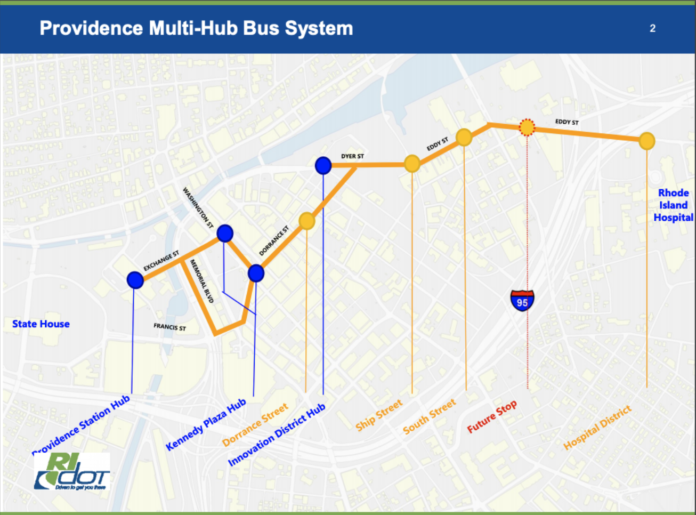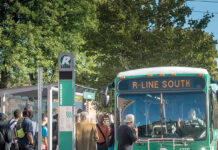
PROVIDENCE – The Providence Foundation has joined transit advocates in voicing their opposition to parts of the state’s latest bus route proposal.
The proposed plan, called the Providence Multi-Hub Bus System, which was announced in July, involves bus hubs scattered across downtown Providence, including at the Interstate-195 Redevelopment District, Kennedy Plaza and Providence Station. It is intended to improve service for passengers who use both transit and rail through the capital city.
Russell C. Carey, Providence Foundation chairman, and Clifford J. Wood, the executive director, signed the four-page letter to the R.I. Department of Transportation Director Peter Alviti Jr. on Sept. 3 and made it clear that they did not support one of the proposed bus hubs.
“Much of what the proposal accomplishes is proposed to be achieved by relocating approximately half of the bus traffic currently flowing through Kennedy Plaza to a small and constrained parcel adjacent to the Providence River east of Dyer Street,” read the letter addressed to Alviti. “Providence has a finite amount of waterfront and to occupy even a small amount of it with a bus depot strikes us as not being the best and highest use of that land.”
RIDOT spokesman Charles St. Martin said the department is listening to the comments and criticisms on the project and is working to resolve “as many of them as [they] can”
“With regard to the hub in the Innovation District, we are assessing other sites that the foundation mentioned in its letter and we expect to have that assessment completed within a week,” said St. Martin. He said he does not yet know how or when that assessment will be made public.
Under the proposal, almost 50% of routes would move out of Kennedy Plaza. Some bus riders would go to Dyer Street, near the Garrahy Judicial Complex, and others would go to Providence Station.
The letter asserted pedestrian and cyclist safety is already challenging at Dyer and Eddy streets, let alone if nearly half of the Kennedy Plaza bus traffic is added to Dyer Street.
“We are, therefore, not supportive of the Jewelry District hub in the location RIDOT has proposed,” said the letter.
According to the letter, the foundation played a key leadership role in successfully persuading Rhode Island voters to support the $35 million Mass Transit Hub Infrastructure Bond in 2014 and look for any proposals using these bond funds to go toward improving Rhode Island’s public transit and public spaces, be cost effective and identify and include ongoing, budgeted support for public safety, maintenance and appropriate public programming.
Carey and Wood wrote that they too share RIDOT’s sense of urgency and desire to get these projects underway, but that these are investments that will last for decades.
“It is critical that [these projects] be made in a manner in which we all have confidence and enthusiasm,” read the letter.
As previously reported, transit users and advocates said the state was making a mistake in dividing bus routes among three hubs and that the Dyer Street location would make many Rhode Islanders take additional rides in order to get to the center of downtown or the train station.
Providence City Council members said in a recent meeting that the Jewelry District location would extend commutes as many riders would require transfers to reach their destinations.
The foundation’s letter offered some alternatives to RIDOT’s plan, such as the already proposed bus hub and commercial development on the surface of parking lots west of Dyer Street and east of the Garrahy Courthouse, which is bounded by Clifford, Dorrance and Peck Streets.
“This location would make for an inviting and amenity-rich transit hub, incentivize development on and around these parcels, and be a gateway along the DTC between downtown and the Jewelry District,” read the letter. “It is on the correct side of Dyer for a bus hub, and it’s adjacency to Dorrance creates further optionality for RIPTA routes now and in the years to come.”
A second alternative, Carey and Wood point out, is a further examination of Providence Station, which already features connectivity to trains, rider amenities and services, covered wait areas and room for potential expansion.
The third alternative, the letter went on, is the recently constructed Garrahy Courthouse Garage, which was previously considered for a bus hub. Bus traffic and stops could be located around the exterior of the structure with rider amenities and services, including restrooms, ticketing, food, undercover waiting areas and potentially a police sub-station, read the letter.
Not all aspects of the proposal were disputed by the Foundation. In the letter, the Foundation said the proposal would accomplish many objectives such as reducing congestion and density of bus transit in Kennedy Plaza while also connecting bus and train transit at Providence Station.
“Vibrant and economically successful cities and communities have thriving public transportation networks,” read the letter. “The people of Providence and Rhode Island deserving nothing less and we are fully supportive of achieving those goals.”
The letter was also allegedly sent to Gov. Gina M. Raimondo, Providence Mayor Jorge O. Elorza, Sen. Jack Reed, RIPTA CEO Scott Avedisian, RIPTA Board of Directors Chair Normand Benoit and Providence’s Director of Planning Bonnie Nickerson.
Alexa Gagosz is a PBN staff writer. Contact her at Gagosz@PBN.com. You may also follow her on Twitter at @AlexaGagosz.
This story has been updated to include comment from the R.I. Department of Transportation.










